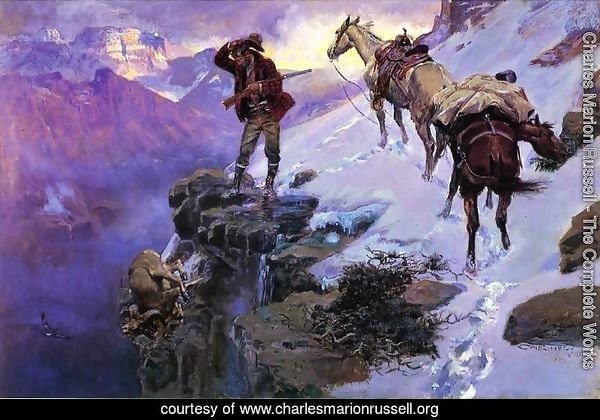Charles Marion Russell is an outstanding American artist, sculptor, illustrator, and fairy tale storyteller. In his work, he glorified the romance of the American wild west, depicted the life of cowboys, Indians, landscape painting, hunting, and wildlife. One of the brightest and most revered representatives of western art.
So, here are 10 facts about Charles Russell.
1. At 16, dropped out of school
Born on March 19, 1984, near St. Louis, Missouri. It was the outskirts of the western world. C.M. Russell was not very keen on studying. In early childhood, he painted cowboys and Indians in the fields of school notebooks. He drew caricatures of his classmates, thereby gaining the authority of a cheerful and talented minor among his peers. He had no desire to become an artist, but he dreamed of the wild west, becoming a part of it like a cowboy. As a result, at the age of 16, young Russell dropped out of school and never returned there, even to study artistic skills.
Self Portrait

2. Worked on a ranch
After young Charles left school, he went west to fulfill his dream of becoming a cowboy. Fascinated by the values and romance of the American wild west, he moves to Montana to take a job as a shepherd on a ranch. There he draws his first sketches of local life. His deep knowledge of life and his involvement in its culture contributed to the creation of realistic stories that became a characteristic feature of his personal style.
Cowboy Bargaining for an Indian Girl
3. Work report and illustrated letters
When C.M. Russell worked at a ranch in Montana, a very harsh winter came. The owner asked to write to him in a letter, how the herd of cattle survived the winter. In response, young Charles painted a watercolor postcard with a picture of a stable and a hungry wolf watching it from afar. The rancher showed the card to his influential friends, and it was even sent to an art shop. This was his first illustrated letter. More than 200 such letters were published in the collection by his wife after the death of the artist.
4. The wife was his support
In 1896, Charles Russell married Nancy Cooper. After their marriage, they moved and settled in Great Falls, Montana. It was the wife who was the main organizer of his exhibitions and shows around the world. It was the merit of his wife that C.M. Rassel`s works have become so famous and in demand.
5. Adoption
Charles and Nancy didn`t have their own children. In 1916, they adopted a boy named Jack. They loved him as their own son. And this love motivated Russel to write many fascinating tales.
6. Sculptures are more expensive than paintings
Charles Russell became famous as a talented sculptor. During his life, he created more than 500 and most of them were cast in bronze. After the death of her husband, Nancy organized many exhibitions in Europe and America. Most of the sales were sculptures. People bought them more often and priced more expensive than oil painting. The sculptures of western art by Charles Russell are highly valued to this day. In 2008, his bronze sculpture Buffalo Hunt was sold for a record $ 4.1 million.

7. Fairytale Narrator
In addition to the outstanding oil painting and statues dedicated to the wild American West, Charles Russell was known as a storyteller. After his death, a short story collection called Trails Plowed Under was released, which was also illustrated by his cowboy drawings.
8. Immortalized by a sculpture in the Capitol
One of the first admirers of Russell’s early art and collector of his paintings, Sid Willis, helped pass the bill to the Montana state legislature. It allowed placing the artist’s sculpture in the National Capitol Hall of Sculpture, Washington. The decision was made back in 1929. However, disagreements about the author, who would have to perpetuate the memory of the artist, dragged on for many years. The governor of the state and the widow of Charles Russell had different opinions on this matter. And only in 1959 the sculpture of Russell, made by the sculptor Butte John B. Weaver, took its place of honor in the walls of the Capitol.
9. From $ 5600 per collection to $ 5.6 million per picture
After the death of Nancy Russell, she appointed George R. Miller, a stockbroker from Pasadena, to be the steward of the sale of the artist’s heritage. He was to engage in the sale of a large collection consisting of more than 130 bronze sculptures and 90 paintings and drawings by the great master. In addition to the will, she wanted her husband’s collection to be sold to a single worthy person or museum. She wanted the whole collection to be presented for future generations. However, the first specialist evaluating the collection appreciated all the work to cost a little more than $ 5,000. As a result, after a few more evaluations and a search for a heritage buyer, the entire collection was sold for $ 40,000 but was subsequently resold in parts.
Piegans
Now Russell`s work is much more expensive. So, in 2005, his painting Piegans was sold for $ 5.6 million, and after 3 years, the work with The Hold Up oil went under the hammer for $ 5.2 million.
10. The Heritage of Jack Russell
After the death in 1926, C.M. Rassel left for future generations over 4,000 works written in oil, watercolors, ink, hundreds of illustrated letters. He also left the descendants more than 500 bronze and wax sculptures. The objects of his unique western art became an adornment of antique salons, private collections, and the most top museums. His works may be seen in higher diplomatic institutions, and in the buildings of bodies of the highest state power, including the White House.



